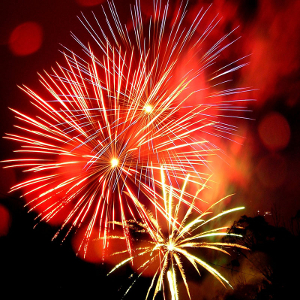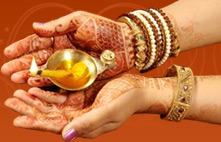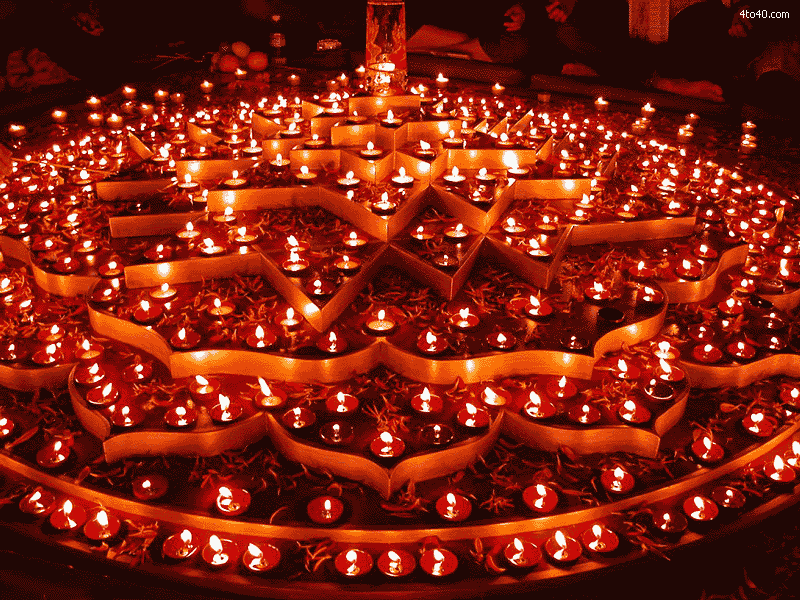Diwali is one of the biggest festival of Hindus, celebrated with great enthusiasm and happiness in India. The festival is celebrated for five continuous days, where the third days is celebrated as the main Diwali festival or ‘Festival of lights’. Different colorful varieties of fireworks are always associated with this festival. On this auspicious day, people light up diyas and candles all around their house. They perform Laxmi Puja in the evening and seek divine blessings of Goddess of Wealth. The festival od Diwali is never complete without exchange of gifts. People present diwali gifts to all near and dear ones.
When is Diwali celebrated?
 Diwali is celebrated for 5 days according to the lunar Hindu Calendar. It begins in late Ashwin (September-October) and ends in early Kartika (October-November). The first day is Dhan Teras. The last day is Yama Dvitiya, the 2nd day of the light half of Kartika. Each day marks one celebration of the six principal stories associated with the festival.
Diwali is celebrated for 5 days according to the lunar Hindu Calendar. It begins in late Ashwin (September-October) and ends in early Kartika (October-November). The first day is Dhan Teras. The last day is Yama Dvitiya, the 2nd day of the light half of Kartika. Each day marks one celebration of the six principal stories associated with the festival.
Significance in Hinduism
While Diwali is popularly known as the “festival of lights”, the most significant spiritual meaning is “the awareness of the inner light”. Central to Hindu philosophy is the assertion that there is something beyond the physical body and mind which is pure, infinite, and eternal, called the Atman. Just as we celebrate the birth of our physical being, Diwali is the celebration of this inner light, in particular the knowing of which outshines all darkness (removes all obstacles and dispels all ignorance), awakening the individual to one’s true nature, not as the body, but as the unchanging, infinite, immanent and transcendent reality. With the realization of the Atman comes universal compassion, love, and the awareness of the oneness of all things (higher knowledge). This brings Ananda (inner joy or peace).
The gunas are the underlying forces or tendencies which one needs to have unaffected, direct relation with in order to find effectiveness and righteousness in life: they are lines of potential and illuminate thought and action, thus the inner meaning of Diwali being the festival of lights.
Diwali celebrates this through festive fireworks, lights, flowers, sharing of sweets, and worship. While the story behind Diwali varies from region to region, the essence is the same – to rejoice in the inner light (Atman) or the underlying reality of all things (Brahman).
Hindus have several significant events associated with it:
- The Return of Sri Ram after 14 years of Vanvas(banishment). People at that time lit rows of lamps in his welcome.
- The Killing of Narakasura: Celebrated as Narak Chaturdashi, one day before Diwali day, it commemorates the killing of Narakasura, an evil demon who created havoc, by Krishna’s wife Satyabhama. This happened in the Dwapara Yuga during this time of Krishna’s avatar. In another version, the demon was killed by Krishna (Krishna provokes his wife Satyabhama to kill Narshna) defeating Indra: Govardhan Puja is celebrated the day after Diwali. It is the day Krishna defeated Indra, the deity of thunder and rain. As per the story, Krishna saw huge preparations for the annual offering to Lord Indra and questions his father Nanda about it. He debated with the villagers about what their ‘dharma’ truly was. They were farmers, they should do their duty and concentrate on farming and protection of their cattle. He continued to say that all human beings should merely do their ‘karma’, to the best of their ability and not pray for natural phenomenon. The villagers were convinced by Krishna, and did not proceed with the special puja (prayer). Indra was then angered, and flooded the village. Krishna then lifted Mt Govardhan and held it up as protection to his people and cattle from the rain. Indra finally accepted defeat and recognized Krishna as supreme. This aspect of Krishna’s life is mostly glossed over but it set up the basis of the ‘karma’ philosophy later detailed in the Bhagavat Gita.
Diwali celebrations are spread over five days in India and all over the world. All the days except Diwali are named according to their designation in the Hindu calendar.
Diwali being festival of lights, across India people celebrate it via symbolic diyas or kandils (colorful paper lanterns) as an integral part of Diwali decorations.
Rangoli, decorations made from colored powder, is popular during Diwali
- Vasu Baras (27 Ashvin or 12 Krishna Paksha Ashvin): Baras means 12th day and vasu means cow. On this day cow and calf are worshipped.
- Dhanatrayodashi or Dhan teras (28 Ashvin or 13 Krishna Paksha Ashvin): Dhan means “wealth” and Trayodashi means “13th day”. Thus, as the name implies, this day falls on the 13th day of the second half of the lunar month. It is an auspicious day for shopping of utensils and gold.This day is also regarded as the Jayanti of God Dhanvantri who came out during the churning of the great ocean by the gods and the demons.
- Naraka Chaturdashi (29 Ashvin or 14 Krishna Paksha Ashvin): Chaturdashi is the fourteenth day on which demon Narakasura was killed by god Krishna – an inacranation of god Vishnu. It signifies the victory of good over evil and light over darkness (Gujarati: Kali Chaudas, Rajasthan : Roop Chaudas). In south India, this is the actual day of festivities. Hindus wake up well before dawn, as early as two in the morning, have a fragrant oil bath and wear new clothes. They light small lamps all around the house and draw elaborate kolams /rangolis outside their homes. They perform a special puja with offerings to Krishna or Vishnu, as he liberated the world from the demon Narakasura on this day. It is believed that taking a bath before sunrise, when the stars are still visible in the sky is equivalent to taking a bath in the holy Ganges. After the puja, children burst firecrackers heralding the defeat of the demon. As this is a day of rejoicing, many will have very elaborate breakfasts and lunches and meet family and friends.
- Lakshmi Puja (30 Ashvin or 15 Krishna Paksha Ashvin): Lakshmi Puja marks the most important day of Diwali celebrations in North India. Hindu homes worship Lakshmi, the goddess of wealth, and Ganesh, the God of auspicious beginnings, and then light lamps all across the streets and homes to welcome prosperity and well-being.
- Bali Pratipada and Govardhan Puja (1 Kartika or 1 Shukla Paksha Kartika) : In North India, this day is celebrated as Govardhan Puja, also called Annakut, is celebrated as the day Krishna – an incaranation of god Vishnu – defeated god Indra and by the lifting of Govardhana hill to save his kinsmen and cattle from rain and floods. For Annakut, a mountain of food is decorated symbolizing Govardhan hill lifted by Krishna. In Maharashtra, Tamil Nadu and Karnataka, it is celebrated as Bali-Pratipada or Bali Padyami. The day commemorates the victory of Vishnu in his dwarf form Vamana over demon-king Bali, who was pushed to the nether world and the return of Bali to earth from the nether-world. In Maharashtra, it is called as Padava or Nava Diwas (“new day”). Men present gifts to their wives on this day. It is celebrated as the first day of the Vikram Samvat calender, in Gujarat.
- Bhaiduj (also Bhayyaduj, Bhaubeej or Bhayitika) (2 Kartikaor 2 Shukla Paksha Kartika): on this day, brothers and sisters meet to express their love and affection for each other (Gujarati: Bhai Bij, Bengali: Bhai Phota). It is based on a story when Yam, lord of Death, visited his sister Yami. Yami welcomed yam with an Aarti and they had a feast together. Yam gave a gift to Yami while leaving as a token of his appreciation. So, the day is also called ‘YAM DWITIYA’. Most Indian festivals bring together families, Bhaiduj brings together sisters and brothers, and is a significant festive day for them. This festival is ancient, and pre-dates ‘Raksha Bandhan’ another brother-sister festival celebrated in the present day.
Lakshmi Puja
Diwali marks the end of the harvest season in most of India and Nepal. Farmers are thankful for the plentiful bounty of the year gone by, and pray for a good harvest for the year to come. Traditionally this marked the closing of accounts for businesses dependent on the agrarian cycle, and the last major celebration before winter. Lakshmi symbolizes wealth and prosperity, and her blessings are invoked for a good year ahead.
There are two legends that associate the worship of Lakshmi on this day. According to the first legend, on this day, Lakshmi emerged from Kshira Sagar, the Ocean of Milk, during the great churning of the oceans, Samudra manthan. The second legend (more popular in western India) relates to the Vamana avatar of Vishnu, the incarnation he took to kill the demon king Bali. Thereafter it was on this day, that Vishnu came back to his abode, the Vaikuntha; so those who worship Lakshmi on this day, get the benefit of her benevolent mood, and are blessed with mental, physical and material well-being.
As per spiritual references, on this day “Lakshmi-panchayatan” enters the Universe. Vishnu, Indra, Kubera, Gajendra and Lakshmi are elements of this “panchayatan” (a group of five). Add more The tasks of these elements are:
- Lakshmi: Divine Energy (Shakti) which provides energy to all the above activities.
- Vishnu: Happiness (happiness and satisfaction)
- Kubera: Wealth (Generosity; one who gives away wealth)
- Indra: Opulence (satisfaction due to wealth)
- Gajendra: Carries the wealth



